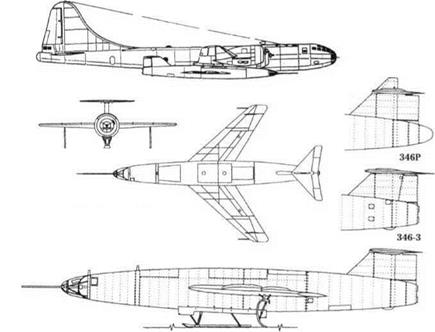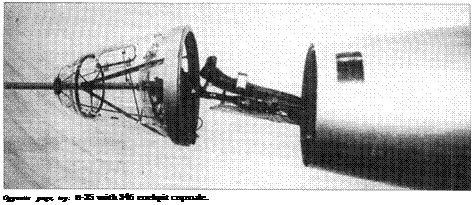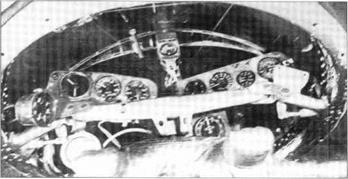Type 346

![]()
![]()



Purpose: To continue German development of a supersonic rocket aircraft.
Design Bureau: OKB-2 at Podberez’ye, lead designer Hans Rosing, in October 1948 replaced by S M Alekseyev.
On 22nd October 1946 a second group of German design engineers was formed at Pod – berez’ye to continue development of the DFS – 346 supersonic research aircraft originally designed at the DPS (German institute for gliding) at Griesheim near Darmstadt. Models, some made in Germany, were tested in CAHI (TsAGI) tunnels, and a North American B-25 was fitted with a mock-up nose to test the cockpit jettison system. In 1947 (date not discovered) the 346P (P from planer, glider) unpowered version was taken to the test airfield at Tyoplyi Stan and dropped from under the starboard wing of a captured B-29 (previously USAAF 42-6256). Amazingly, the 346P was flown not by a Russian but by Wolfgang Ziese, who had previously been chief test pilot of the German Siebel Flugzeugwerke. He had no problems, and brought the glider to a normal landing. In 1948 (date not discovered) the 3461 high-speed glider version, also known as the 346A, was released from a Tu-4 (B-29 copy) and similarly flown by Ziese to a normal landing. On 30th September 1949 the 346-2, also known as the 346D, was dropped from the B-29 and flown as a glider by Ziese even though it was fitted with rocket propulsion. No propellant was loaded, so the aircraft was much lighter than it would have been with full tanks. Despite this Ziese landed too fast and, more seriously, the landing skid failed to extend, resulting in serious damage to both the aircraft and pilot. This aircraft was repaired, and in October 1950 LII pilot P I Kasmin flew it at Lukhovitsy, according to the record making a normal take-off from the runway despite having only skid landing gear. Ziese recovered, and on 13th August 1951 he flew the final aircraft of this programme, the 346-3, and fired the engines. He flew again on 2nd September, but on the third flight, on 14th September, he lost control. He managed to separate the jettisonable nose from the tumbling aircraft, but this ended the programme. Later versions were abandoned. Various 346 parts were donated to the Moscow Aviation Institute.
Like its American counterpart the Bell XS-1, the 346 was an almost perfectly streamlined body with mid-mounted wings. Unlike the XS – 1, it had a prone pilot position, skid landing gear, swept wings and an extremely squat vertical tail with the tailplane on top. Construction was almost wholly flush-riveted light alloy. The wings had NACA-012 profile (12 per cent thick) and a sweep angle of 45° at the /4-chord line. Each wing had two shallow fences from the

![]()



 leading edge to the plain flap. At the tips were inverse-tapered two-section ailerons, the inner sections being locked at high airspeeds. The elevators were similar in principle. On the 346P the tailplane, with!4-chord sweep of 35°, was fixed and surmounted by a small fixed fin. On the 346-2 and -3 the tailplane was driven by an irreversible power unit over the range -2° 407+2°. The fuselage was of circular section, with the entire nose arranged to slide forward for pilot entry and to jettison in emergency. The pilot lay on his stomach looking ahead through the Plexiglas nosecap, through which protruded the long instrumentation boom. Bottled gas pressure operated the flaps and retracted the skid into a ventral recess which, except for the 346P, could be faired over with twin doors. Under the tail was a small steel bumper. Unlike its predecessors, the 346-3 could be fitted with a curved skid with a levered shock strut hinged under each outer wing. These were jettisoned after take-off. The propulsion system was the Walter HWK 109- 509C, called ZhRD-109-510 in the USSR. This had two superimposed thrust chambers, one which fired continuously whenever the system was in operation, and a larger chamber used only for take-off or for brief periods when maximum thrust was needed. The cruise chamber was rated at sea level at 300kg (661 Ib), and the main chamber at 1,700kg (3,7481b). The combined thrust at high altitude was about 2,250kg (4,960 Ib). Immediately behind the jettisonable nose section was a tank of concentrated hydrogen peroxide (called T-Stoff in Germany) while in the centre fuselage were interconnected tanks of methanol/hydrazine hydrate (C-Stoff). German turbopumps running on calcium permanganate fed the highly reactive fluids to the thrust chambers, where ignition was hypergolic (instantaneous).
leading edge to the plain flap. At the tips were inverse-tapered two-section ailerons, the inner sections being locked at high airspeeds. The elevators were similar in principle. On the 346P the tailplane, with!4-chord sweep of 35°, was fixed and surmounted by a small fixed fin. On the 346-2 and -3 the tailplane was driven by an irreversible power unit over the range -2° 407+2°. The fuselage was of circular section, with the entire nose arranged to slide forward for pilot entry and to jettison in emergency. The pilot lay on his stomach looking ahead through the Plexiglas nosecap, through which protruded the long instrumentation boom. Bottled gas pressure operated the flaps and retracted the skid into a ventral recess which, except for the 346P, could be faired over with twin doors. Under the tail was a small steel bumper. Unlike its predecessors, the 346-3 could be fitted with a curved skid with a levered shock strut hinged under each outer wing. These were jettisoned after take-off. The propulsion system was the Walter HWK 109- 509C, called ZhRD-109-510 in the USSR. This had two superimposed thrust chambers, one which fired continuously whenever the system was in operation, and a larger chamber used only for take-off or for brief periods when maximum thrust was needed. The cruise chamber was rated at sea level at 300kg (661 Ib), and the main chamber at 1,700kg (3,7481b). The combined thrust at high altitude was about 2,250kg (4,960 Ib). Immediately behind the jettisonable nose section was a tank of concentrated hydrogen peroxide (called T-Stoff in Germany) while in the centre fuselage were interconnected tanks of methanol/hydrazine hydrate (C-Stoff). German turbopumps running on calcium permanganate fed the highly reactive fluids to the thrust chambers, where ignition was hypergolic (instantaneous).
Probably as much effort went into the 346 programme as the Americans expended on the XS-1 or D-558-II, but there was no comparison in what the programmes achieved. There is no obvious reason why these challenging aircraft, designed for Mach 2, should simply have been abandoned without even reaching Mach 1.
Dimensions
Span 9 m 29 ft 6% in
Length
(346-3, nose to engine nozzles) 13.447 m 44 ft IK in (instrument boom to tailplanes) 15.987 m 52 ft 3SA in Wing area (net) 14.87nf 160ft2
Weights (346-3)
Empty 3,180kg 7,01 lib
Propellants 1,900kg 4,1891b
Loaded 5,230kg ll,5301b










